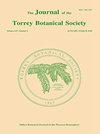长春花的生殖生物学研究倒钩。安大略省外来入侵植物(Asclepiadaceae)
IF 0.8
4区 生物学
Q4 PLANT SCIENCES
引用次数: 25
摘要
ST. DENIS, M. AND N. CAPPUCCINO(卡尔顿大学生物系,渥太华,安大略省,K1S 5B6 Canada)。长春花的生殖生物学研究倒钩。(Asclepiadaceae),一种入侵安大略省的外来植物。j·托里·博特。SOC。131:8-15。2004.-研究了外来入侵藤本植物长春花(winectoxicum rosicum, Asclepiadaceae)的生殖生物学特性,并评估了野外传粉者对孤立植物和密集单一栽培植物花的访花率(以缺失传粉者为证据)。在密集的单一栽培植物上的花被访问的频率低于那些被老草地包围的孤立植物上的花。拜访过的花更容易结出果实,果实中含有更多的多胚种子。然而,在自花授粉的温室实验中,我们发现在坐果、种子产量、种子重量或胚胎方面没有差异。这表明,田间访花的高坐果率和多胚率不是访花的结果,而可能是访花者选择了最旺盛的花的结果。在温室实验中,被阉割了一天的花偶尔会结出果实,这表明自花开花的那天起,自花花粉就开始发芽了。产生大量自交种子的能力无疑对这种高度侵入性的植物是有利的。本文章由计算机程序翻译,如有差异,请以英文原文为准。
Reproductive biology of Vincetoxicum rossicum (Kleo.) Barb. (Asclepiadaceae), an invasive alien in Ontario'
ST. DENIS, M. AND N. CAPPUCCINO (Department of Biology, Carleton University, Ottawa, Ontario, K1S 5B6 Canada). Reproductive biology of Vincetoxicum rossicum (Kleo.) Barb. (Asclepiadaceae), an invasive alien in Ontario. J. TORREY BOT. SOC. 131:8-15. 2004.-We investigated the reproductive biology of the alien invasive vine Vincetoxicum rossicum (Asclepiadaceae) and evaluated pollinator visitation rate in the field, evidenced by missing pollinaria, to flowers of isolated plants and those of plants in dense monocultures. Flowers in dense monocultures were visited less frequently than those on isolated plants surrounded by old-field grasses. Visited flowers were more likely to produce fruit and those fruits contained more polyembryonic seeds. However, a greenhouse experiment in which we crossor self-pollinated flowers revealed no difference in fruit set, seed production, seed weight or embryony. This suggests that the higher fruit set and greater polyembryony of visited flowers in the field was not the consequence of visitation, but may have been the result of floral visitors having chosen the most vigorous flowers. Day-old flowers emasculated in the greenhouse experiment occasionally produced a fruit, indicating that the germination of self-pollen begins the day a flower opens. The ability to produce large numbers of selfed seeds is no doubt advantageous to this highly invasive asclepiad.
求助全文
通过发布文献求助,成功后即可免费获取论文全文。
去求助
来源期刊
CiteScore
0.70
自引率
0.00%
发文量
16
审稿时长
>12 weeks
期刊介绍:
The Journal of the Torrey Botanical Society (until 1997 the Bulletin of the Torrey Botanical Club), the oldest botanical journal in the Americas, has as its primary goal the dissemination of scientific knowledge about plants (including thallopyhtes and fungi). It publishes basic research in all areas of plant biology, except horticulture, with an emphasis on research done in, and about plants of, the Western Hemisphere.

 求助内容:
求助内容: 应助结果提醒方式:
应助结果提醒方式:


